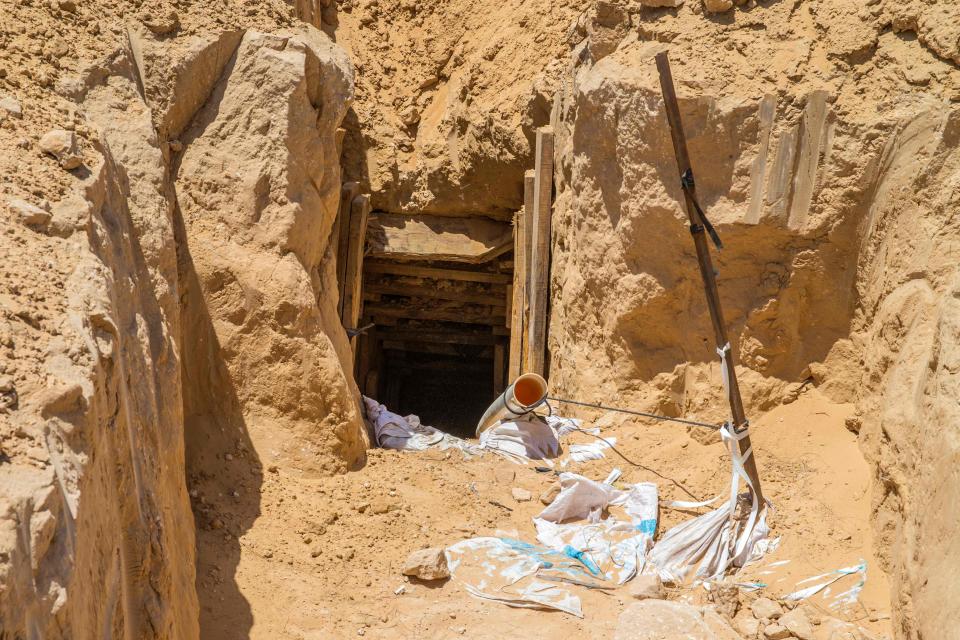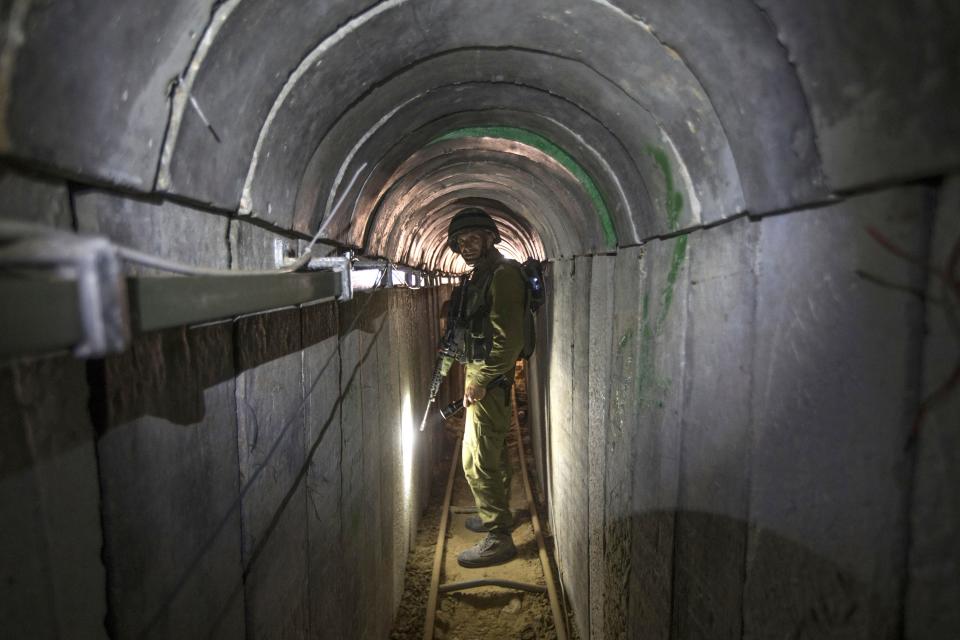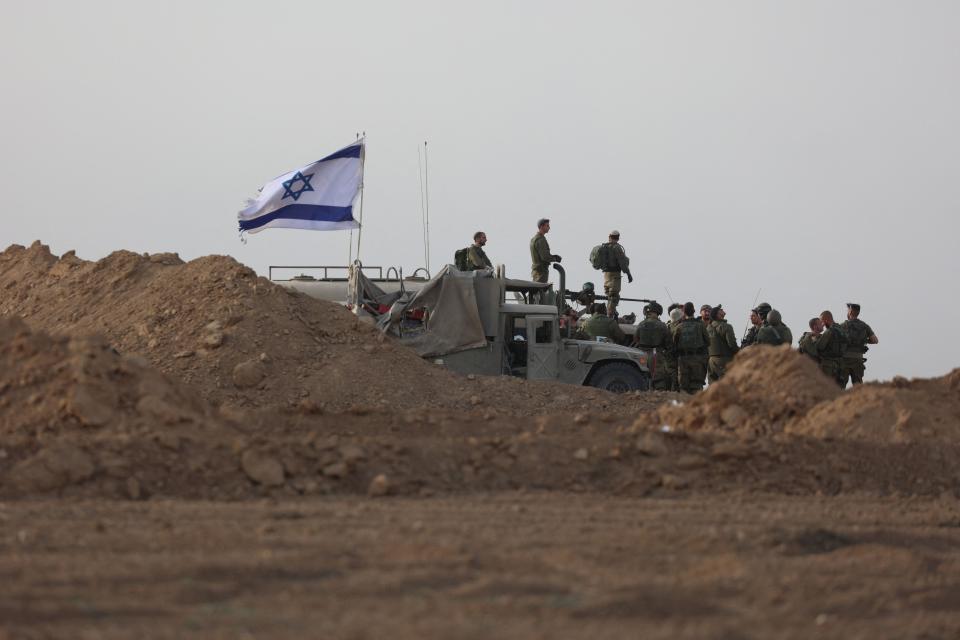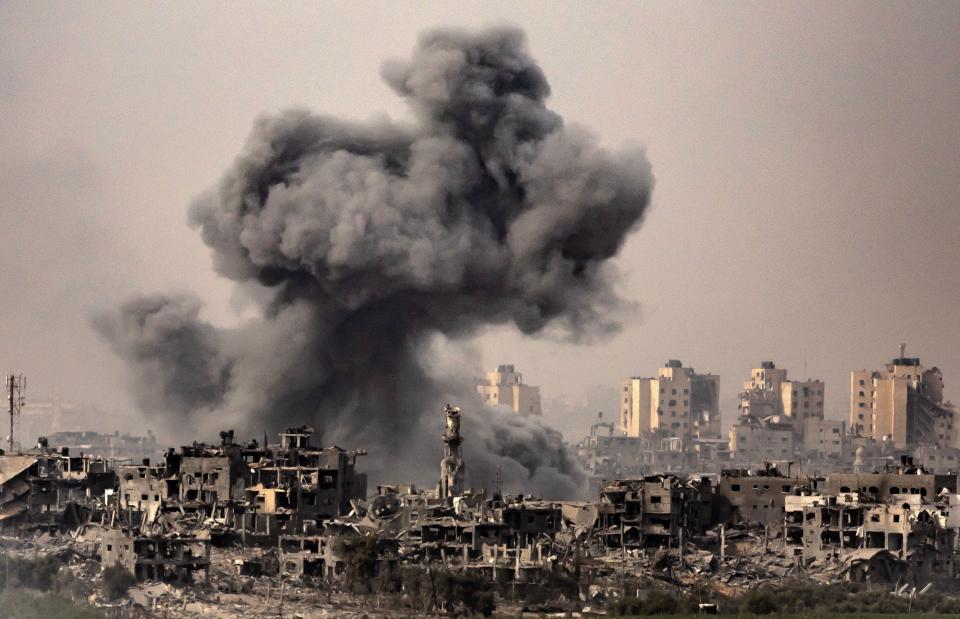Hamas built a massive tunnel network in Gaza. Here’s how Israeli ‘weasel’ forces will fight it
As Israeli troops push deeper into Gaza in retaliation for the Oct. 7 Hamas attacks, the ground attack won’t look quite like the door-to-door skirmishes seen in Fallujah, Mosul and other past urban clashes.
Instead, it will happen largely out of sight and underground, deep in a warren of connecting tunnels that Hamas has been digging and lining with concrete for more than a decade. The battle to control and destroy this subterranean labyrinth, estimated at more than 300 miles, will be a key strategy for the Israeli military, according to military analysts and experts – and will make the incursion into Gaza unlike any past urban conflict.
For these “de-tunneling” operations, specialized units code-named Samur – Hebrew for “weasel” – expect to squeeze through the narrow passages and find rocket assembly lines, stores of small arms and mortars and, deeper still, Hamas’ leaders’ lodging and headquarters – much of it probably booby-trapped with homemade bombs. They may also be searching for some of the more than 200 hostages taken from Israel who may be hidden in those same tunnels.
“It’s going to be an undertaking like nothing the (Israeli military) has ever done,” said retired U.S. Army Lt. Gen. Mark Schwartz, who ran U.S. security coordination with both Israel and the Palestinian Authority from 2019 to 2021. “And frankly unlike anything we’ve ever done.”

After the Hamas attacks, which killed 1,400 people, Israel unleashed a bombing campaign that has killed more than 8,000 people, most of them civilians, according to the Hamas-run health ministry. Israeli officials have said they are targeting Hamas operatives and infrastructure. The response by Israeli ground troops, now underway by degrees, will bring the next phase of the fight – including the fight for the tunnels.
The Biden administration has sent some of its most seasoned insurgency experts from the war in Iraq and against the Islamic state to advise the Israelis, including three-star Marine Corps Gen. James Glynn, who commanded troops in Fallujah during the Iraq War. In the second battle for Fallujah in November 2004, more than 10,000 U.S. troops went house-to-house clearing the city of 3,000 insurgents in what became the bloodiest battle of the war. Nearly 100 U.S. troops and 2,000 insurgents were killed.
The fight in Gaza may bear some similarities to operations in Fallujah, or in Mosul, where U.S.-backed Iraqi forces flushed Islamic state fighters out of a tunnel network in 2014.
But in Gaza, Israeli forces face more formidable infrastructure and more challenging geography.
Hamas’ tunnel system is more advanced, and its fighters are better trained, more disciplined and better equipped than the Islamic state fighters, said Eitan Shamir, director of the Begin-Sadat Center for Strategic Studies at Bar-Ilan University in Tel Aviv, Israel.
“It’s a major challenge,” Shamir said. “This is a very messy affair.”
And in Gaza – hemmed in by Israel, Egypt and the Mediterranean Sea, which gives civilians nowhere to flee – a ground war is uniquely challenging, said Seth Jones, a military analyst at the Washington-based Center for Strategic and International Studies.
"The intricate nature of the tunnel complex in a densely packed urban environment that is entirely fenced in makes this a fundamentally different – and in many ways more difficult – environment than what U.S. forces had to face in cities like Fallujah or Mosul," he said. “The possibility of civilian casualties is much greater in Gaza.”
More: Why a Gaza ground invasion will be bloody, fraught and expensive
Building tunnels for a decade

Palestinians have excavated tunnels under Gaza for decades, initially mostly to smuggle people and goods between Gaza and Egypt, according to testimony to the United Nations by Israeli researcher Eado Hecht. Israel and Egypt have tightly controlled their borders to Gaza, creating a virtual blockade on the territory.
In time, three types of tunnels emerged, according to Hecht: In addition to tunnels into Egypt in the south, there are tunnels that cross the border of Gaza into Israel and tunnels that crisscross under Gaza and can be used as command posts, storage facilities and positions to launch mortars or rockets.
The tunnels have become so elaborate and extensive – Hamas leaders claimed in 2021 they stretched for 311 miles, or nearly half the length of the New York City subway system – that the Israeli military dubbed it the “Gaza Metro,” according to a report this month by the Congressional Research Service. Experts believe some tunnels drop as far as 200 feet – roughly the equivalent of a 20-story building, or a typical airport control tower, underground.
Since at least 2014, the Israeli military has accused Hamas of diverting construction supplies meant for civilian aid into tunnel-building instead.
Over the years, the U.S. has lent its expertise – and money – to help Israel locate and destroy the tunnels and develop technologies to combat them. Since 2016, Congress has appropriated $320 million in Defense Department funding for U.S.-Israel collaboration on “detecting, mapping and neutralizing underground tunnels” in response to the cross-border tunnels built by Hamas, according to the CRS report. In 2021, crews completed an underground concrete barrier with anti-tunnel sensors along the entire 40-mile Israel-Gaza border.
The tunnels have fueled Israeli-Hamas violence before. In 2006, Hamas operatives used a tunnel to launch a surprise attack on Israeli forces and kidnap one of its soldiers, Gilad Shalit, who was held captive for five years before being traded for more than 1,000 prisoners in Israeli jails.
The 2014 conflict between Israel and Hamas led to the discovery of 36 cross-border tunnels, most of which were destroyed, Hecht said.

This time, a key challenge will be finding and rescuing the more than 200 hostages held by Hamas, including 12 Americans.
Yocheved Lifshitz, 85, a hostage taken in the Oct. 7 raid and released by Hamas last week, described to reporters how she was taken through a “huge network” of underground tunnels that looked like a “spiderweb.”
She said hostages were made to walk for two to three hours in the tunnels, gathered and ate in a large hall and slept on mattresses in different rooms. “They told us they believe in the Quran and would not harm us,” she said. “They would give us the same conditions as they have in the tunnels.”
Graphics: As Israel preps for ground invasion, a look at the labyrinth of tunnels in Gaza
Remote-control robots and ‘weasel’ special forces
Israeli Prime Minister Benjamin Netanyahu said Saturday that the military has opened a "second stage" in the war against Hamas by sending ground forces into Gaza and expanding attacks from the ground, air and sea.
Among the ground troops in the next phase of the war, experts told USA TODAY, will be specialized units trained to enter, clear and destroy the tunnels.

Since the 2014 Israeli-Hamas conflict, Israel has been gathering intelligence and training troops on how to find and destroy the passageways, said Shamir of Bar-Ilan University. At the center of the effort is a highly secretive laboratory – known simply as “the lab” – where scientists from different fields meet to try to learn tunnel locations and dream up technologies that could penetrate them.
Remote-controlled robots have been developed to enter and search the tunnels. Israeli engineers also have developed technology that uses acoustic or seismic sensors and software to detect digging, similar to the science used by oil and gas companies to detect oil reserves, according to the Congressional Research Service.
Because some tunnels are so deep and are concrete-lined, they can survive heavy bombing, Shamir said. Hamas fighters are thought to have enough provisions to live several months in the subterranean labyrinth, he said.
As Israeli forces rumble into the dense urban quarters of Gaza City, Hamas fighters will use the tunnels to launch surprise attacks on Israeli troops, then melt away underground again and pop up in another location, Shamir said. They’ll also use snipers, improvised explosive devices – or IEDs – and bomb-dropping drones.
Shamir said he believed Israel’s initial incursion into Gaza is more of a tactic to try to pressure Hamas into a negotiated release of the prisoners. As the military moves into denser urban areas and begins destroying tunnels, it becomes exponentially harder to rescue them, he said.
“Everyone understands the chances then are small,” Shamir said.

The task of neutralizing the tunnel advantage will fall to the Yahalom, the special forces unit of the Combat Engineering Corps, who have been training in tunnel combat. A subunit of the Yahalom, the Samur, or "weasel" operators, will enter the tunnels and try to disarm or destroy the passages and look for hostages.
In recent years, the Israeli military has doubled the number of soldiers in Yahalom, expanding its focus to include subterranean fighting, according to the Israel Defense Forces website.
“The main challenge of underground warfare is that the enemy has no above-ground signature,” the website quotes a Yahalom commander as saying. “The fact that the enemy is hidden and collecting intelligence is complicated and difficult.”
Though Israeli forces may not know the precise entrance of every tunnel, they’ve been monitoring for years where cement-mixing trucks in Gaza have been deployed to give them an idea, Edward Luttwak, an Israeli strategist and historian, wrote in an essay this month.
Israeli tunnel specialists will be ferried by 70-ton Namer infantry combat vehicles, considered some of the most heavily armored vehicles in the world, he wrote. As they reach suspected tunnel sites, several Namers will form a perimeter – “an improvised fortress” – protecting the combat engineers.
“In 2014, the last time Israeli troops fought in Gaza, most were riding thinly armored M.113s, which were easily penetrated by RPG anti-tank rockets, with some 60 soldiers killed and hundreds wounded,” Luttwak wrote. “Not this time.”
Schwartz, who coordinated training with Israeli and Palestinian Authority security forces, witnessed some of the tunnel training in Israel. The Israeli military re-created what they believe the Gazan tunnels look like and sent soldiers through the maze to test weaponry and tactics, as well as unmanned vehicles and robotics.
“They know what they’re going to experience,” Schwartz said. “But the magnitude of what they’re going to deal with compared with what they’ve done in the past is very different.”
Keep up with developments from Gaza: Sign up for our Israel-Hamas War newsletter.
This article originally appeared on USA TODAY: Hamas tunnels are the 'Gaza Metro.' Here's how Israel plans to fight